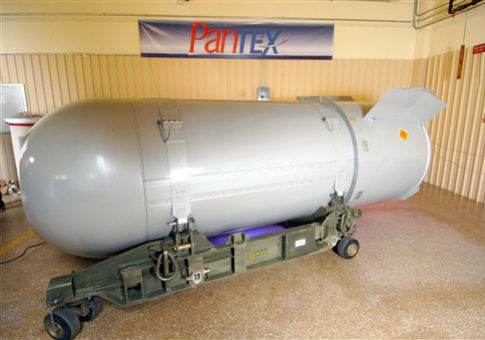Despite nuclear saber-rattling by Moscow, U.S. nuclear forces are close to reaching warhead, missile, and bomber numerical cuts required under the 2010 New START arms treaty, a senior Pentagon official told Congress on Wednesday.
U.S. nuclear warheads counted under the treaty with Russia were reduced from 1,642 to 1,597 between Sept. 1 and March 1, said Robert Scher, assistant secretary of defense for strategy, plans, and capabilities.
Russian nuclear warheads were cut from 1,632 to 1,582 during the same period, Scher told the House Armed Services strategic forces subcommittee in prepared testimony.
The treaty requires both nations to reduce their deployed strategic warhead arsenals to 1,550 by February 2018.
For land-based and sea-based missiles and bombers, U.S. forces were reduced from 912 to 898, and Russian missiles and bombers were cut from 911 to 890.
The treaty limit for those weapons is 800 strategic delivery vehicles by 2018.
Scher said the reductions continued despite "serious concerns" over souring U.S.-Russia relations.
"Russia’s recent behavior, which currently poses one of our most pressing and rapidly evolving strategic challenges, underscores the importance of stable and robust deterrence," Scher said.
"We are confronted with Russia’s occupation and attempted annexation of Crimea, continuing aggressive Russian actions in eastern Ukraine, Russia’s increasingly aggressive nuclear posturing and threats, including the prospect of nuclear weapons in Crimea, and its violation of the Intermediate-Range Nuclear Forces (INF) Treaty," he added.
Scher was pressed by subcommittee members to say when the administration will take steps to counter the INF violation, which officials have described as deployment of a new Iskander cruise missile.
Efforts to convince the Russians to return to INF treaty compliance so far have been unsuccessful. Scher said several options are being examined to counter the INF violation.
"Our patience is not limitless," he said, when asked when the United States would take action.
China also is engaged in a major strategic nuclear buildup and has so far refused to engage the United States in talks about its forces.
"We maintain several ongoing security dialogues with China, and we continue to express our interest in realizing potential mutual benefits of increased bilateral transparency and deeper engagement regarding nuclear weapons and other strategic issues," Scher said.
The hearing was called as the subcommittee examined President Obama’s fiscal 2016 request for $142 billion for nuclear weapons and infrastructure over the next five years. A total of $8.5 billion was added for force improvements, including equipment and personnel training and weapons security.
Air Force Maj. Gen. Garrett Harencak, assistant chief of staff for strategic deterrence, said some elements of the U.S. nuclear force are so old they would qualify for antique license plates if they were vehicles.
Harencak said from the 1990s to the early 2000s, there was an "erosion of the nuclear mission" in the Air Force. "This period of decline was characterized by a loss of senior leader focus, fragmentation of responsibility, and chronic underinvestment in our personnel, weapon systems, and supporting infrastructure," he said. "While in recent years we have reversed this downward trend and made substantial progress towards addressing these deficiencies and the problems that resulted from them, we recognize considerable work lies ahead."
Subcommittee Chairman Rep. Mike Rogers (R., Ala.) questioned those who testified about how the administration is following through on the recent statement that maintaining strong U.S. nuclear forces is the Pentagon’s highest priority mission.
Rogers said nuclear forces suffered a 20-year "procurement holiday" when funds were not invested.
"Well, it’s time to come back from that holiday and get to work," he said. "In the fiscal environment we are facing it won’t be easy. But if nuclear deterrence is truly the nation’s number-one priority defense mission—and I strongly agree that it is—then budgets and policies must follow."
On Russia, Rogers said: "Our position should be clear: as Russia continues to rattle its nuclear saber, it is the strength of U.S. nuclear forces that makes sure we and our allies will never be intimidated or coerced."
Scher testified that the number of U.S. nuclear weapons "is the smallest it has been since the Eisenhower Administration, and the number of deployed nuclear warheads will continue to go down as we and Russia both reach the New START Treaty limit."
Russia is engaged in a major strategic nuclear modernization program while U.S. nuclear forces are aging and in need of modernization, which has slowed under the Obama administration’s defense spending cuts.
Scher stated that defense sequestration, as mandated by the Budget Control Act, poses a serious threat to the Pentagon’s ability to maintain U.S. nuclear forces as a strategic deterrent. "Sequestration presents the greatest threat to the viability of our sustainment plan," he said.
To prevent nuclear forces from becoming hollow, Scher said support is required for "a viable sustainment and modernization plan, stable funding, and consistent focus."
"We must achieve and maintain the necessary funding balance among three critical areas to allow continued certification that our nuclear weapons remain safe and secure, and to sustain effective deterrence over time," Scher said.
New strategic systems that are facing delays under administration defense cuts include a new nuclear submarine, a new long-range bomber, and a new air-launched cruise missile.
